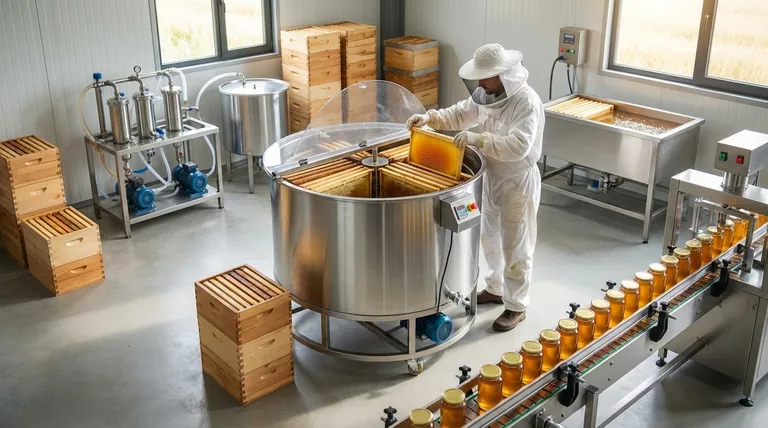In essence, a honey processing machine is an integrated system designed to automate the journey of honey from the raw honeycomb to a finished, bottled product. Its core purpose is to extract, purify, stabilize, and package honey efficiently, ensuring a consistent and high-quality output while minimizing manual labor and maintaining strict hygienic standards.
The true value of a honey processing machine goes beyond simple extraction. It is a tool for transforming raw, variable honey into a stable, commercially viable product by precisely controlling purity, moisture content, and texture to prevent fermentation and crystallization.

The Core Functions: From Comb to Jar
A honey processing machine is not a single device but a series of interconnected components, each performing a critical function. Understanding these stages reveals why mechanized processing is essential for any commercial operation.
Step 1: Efficient Extraction
The process begins with separating the honey from the honeycomb. The machine's extractor uses centrifugal force to spin the honey out of the wax comb structures without damaging them. This is vastly more efficient and less wasteful than manual crushing and draining methods.
Step 2: Critical Purification
Raw honey contains impurities like wax particles, bee debris, and other foreign materials. The system uses a multi-stage filtration process, starting with coarse filters to remove large particles and moving to fine filters to ensure clarity and purity in the final product.
Step 3: Achieving Stability
This is the most critical phase for creating a shelf-stable product. It involves three key actions:
- Gentle Heating: Honey is carefully preheated in jacketed tanks. This lowers its viscosity, making it easier to filter, and helps dissolve fine sugar crystals (nucleation sites) to retard granulation.
- Moisture Removal: To prevent fermentation from naturally occurring yeast, a low-temperature vacuum concentrator removes excess water content. This brings the honey to a stable moisture level without damaging its delicate compounds.
- Homogenization: An agitator or mixer blends the honey to ensure the entire batch has a uniform texture, density, and flavor profile.
Step 4: Automated Packaging
The final component is an automated filling or bottling unit. This injects precise amounts of processed honey into jars or containers, preparing it for sealing, labeling, and distribution with minimal human contact, which is vital for hygiene.
Understanding the Key Trade-offs
While mechanization offers clear benefits in efficiency and consistency, it's important to understand the associated trade-offs. The choices made during processing define the final character of the honey.
Heat Exposure vs. Enzyme Preservation
Gentle heating is necessary for pasteurization (killing yeast) and preventing crystallization. However, overheating can destroy the beneficial enzymes and delicate aromas that define raw, natural honey. High-quality machines use precise temperature controls to mitigate this risk.
Filtration Level vs. Pollen Content
Fine filtration creates exceptionally clear, pure honey that many consumers expect. However, this process can remove pollen grains, which are valued by some for their potential health benefits and as proof of the honey's floral origin. The level of filtration is a significant decision based on target market.
Upfront Investment vs. Long-Term Gains
A complete honey processing line is a significant capital investment. For small-scale beekeepers, the cost may be prohibitive. For commercial operations, however, this cost is weighed against dramatic reductions in labor requirements, increased production speed, and the ability to produce a standardized, shelf-stable product.
Making the Right Choice for Your Goal
Your approach to honey processing should align directly with your production philosophy and business objectives.
- If your primary focus is producing artisanal or "raw" honey: You may choose minimal mechanical intervention, focusing on a simple extractor and coarse filter to preserve the honey's natural state, including its enzymes and pollen.
- If your primary focus is scaling a commercial brand for retail: A full processing machine is non-negotiable for ensuring product safety, consistency, and a long shelf life that prevents fermentation and crystallization on the store shelf.
- If your primary focus is maximizing operational efficiency: Automation is the key. A fully integrated system that handles every step from extraction to bottling delivers the highest productivity and lowest labor cost per unit.
Ultimately, understanding the purpose of each component allows you to produce honey that perfectly matches your quality standards and market goals.
Summary Table:
| Processing Stage | Key Function | Benefit |
|---|---|---|
| Extraction | Uses centrifugal force to spin honey from comb. | Efficient, preserves comb, reduces waste. |
| Purification | Multi-stage filtration removes wax and debris. | Ensures purity and clarity of the final product. |
| Stabilization | Gentle heating & moisture control. | Prevents fermentation & crystallization for long shelf life. |
| Packaging | Automated filling and bottling. | Maintains hygiene, ensures consistency, and speeds up distribution. |
Ready to scale your honey production with efficiency and precision?
At HONESTBEE, we supply commercial apiaries and beekeeping equipment distributors with robust, wholesale-focused honey processing solutions. Our equipment helps you automate from extraction to bottling, ensuring a consistent, high-quality, and shelf-stable product while significantly reducing labor costs.
Contact our experts today to discuss the ideal processing line for your commercial goals!
Visual Guide

Related Products
- HONESTBEE 72 Frame Industrial Electric Honey Extractor for Beekeeping
- 8-Frame Electric Self-Reversing Honey Extractor Spinner for Commercial Honey Extraction Equipment
- 24 Frame Honey Extractor Commercial Radial Honey Frame Extraction Machine
- HONESTBEE 8 Frame Electric and Manual Three Use Honey Extractor
- HONESTBEE 3-Frame Manual Acrylic Honey Extractor
People Also Ask
- How is honey harvested from Langstroth hives? A Guide to Efficient, Comb-Preserving Extraction
- Why is preserving honeycomb integrity important, and how do automated extractors help? Boost Hive Health & Honey Yields
- Can a manual extractor be upgraded to an electric one? Save Labor & Boost Efficiency
- Why do beekeepers have to lift a lot of weight at the end of a growing season? The Reward of a Heavy Harvest
- What are the advantages of automated honey extractors in terms of time efficiency? Boost Your Harvest Speed



















